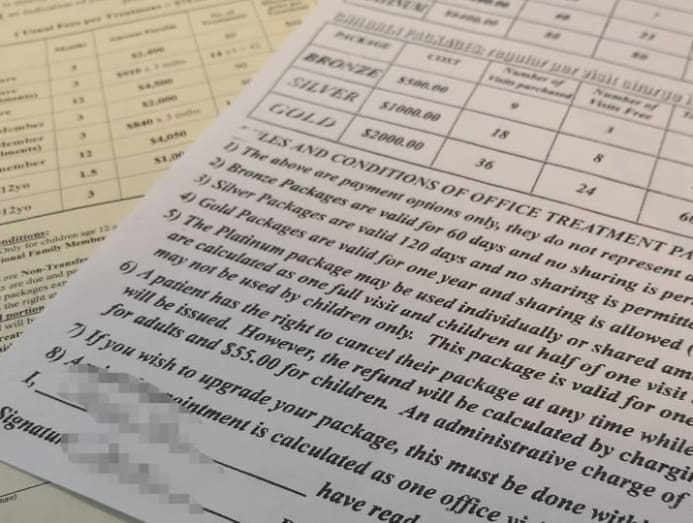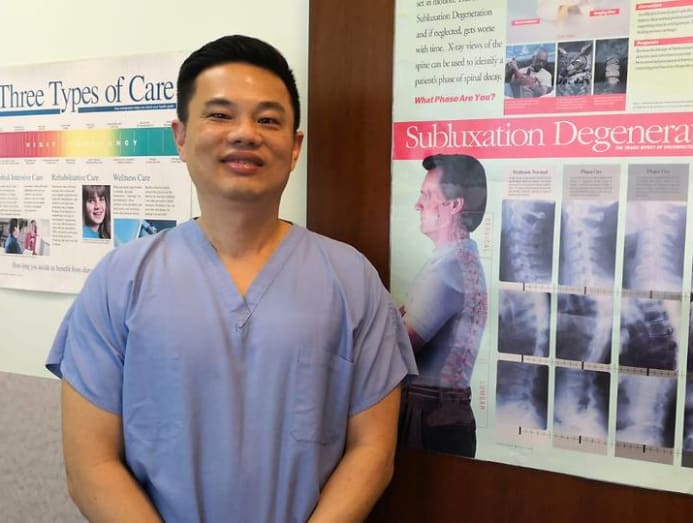Getting rid of a pain in the neck: Chiropractic Association calls for regulation of industry
Despite the prevalence of large packages for chiropractic treatment, the standard approach should be to have a maximum of 12 sessions before re-examination, the Chiropractic Association (Singapore) said.

(Photo: Jesper Aggergaard / Unsplash)
SINGAPORE: Avid mountain biker and golfer Ho Shuwen, suffering from a strain in his neck and back some years ago, walked into a random chiropractor in Bukit Timah Plaza.
Having gone to a chiropractor once before and experienced relief, the 37-year-old business development executive expected the same outcome this time round.
His neck was assessed as being in a bad shape and needing several sessions, so he coughed up more than S$2,000 for 40 treatments. He went diligently three times a week as prescribed for more than a month, but saw no improvement.
He also did not expect what he experienced at the clinic, something he said was like a "conveyor belt system".
“When I was being adjusted, there was already another person lying on the bench beside me, ready to take my place,” he told Channel NewsAsia.
When he asked why he was not getting better, he was told it was because of one session he missed. He decided to stop the treatment, and approached another chiropractor under the Chiropractic Association (Singapore). He found relief after four sessions, he said.
The association currently has about 30 members, making up a third of live chiropractic companies in Singapore.
LARGE PACKAGES BUGBEAR OF INDUSTRY
Chiropractic is a form of complementary and alternative treatment technique that started in the United States and touts itself as a natural remedy for problems related to joints.
President of the association Dr Terrence Yap singled out the practice of peddling large packages by non-member chiropractors as something which can undermine the industry.
“These non-member chiropractic companies would actually try to hard-sell, scare the public into thinking that their condition is so bad that they would need a hundred treatments,” he said.
At his clinic on Orchard Road, he whipped out brochures from such establishments that were selling 40 treatments for S$2,400, or 90 treatments for S$4,050 with the addition of one family member, with the option of instalments. They were brought in by clients who wanted to show proof of what they had gone through.
Such packages make chiropractors seem like hair salons, he said. Dr Yap explained the strategy of such “large-package companies”.

“They hire young fresh grads with huge student loans and entice them to come and practise, to earn as much money as they can. And they do this by dangling a commission-based income. So they usually have a basic salary, which is small, and the commission is where it can vary. The more you sell, the higher your income,” he said.
They would put patients on a high-frequency programme to complete the package and attempt to take another package after that, Dr Yap added.
"Some have even dissuaded patients from seeking other forms of treatment in the hope of getting more business, which is a blatant contradiction to all that has been taught in chiropractic schools and the association," he said.
The association only allows members to perform a course of 12 treatments.
“Then if the patient still needs to be treated, you need to re-examine them before you continue treatment,” he said.
This is in line with international industry guidelines, he said. “Usually within 12 treatments, you can safely say that 60 to 80 per cent of the injuries we commonly see will have 50 per cent of relief,” he said.
Channel NewsAsia approached two such "large package companies" to get some insight into their practices, but they did not respond.
CALL FOR REGULATION
Ensuring that a chiropractor in Singapore is legitimate, however, may prove trickier than expected, given that the industry is currently not regulated here.

Calling for regulation, Dr Yap said: “Being in an unregulated environment means that anybody can call themselves a chiropractor.
“Tomorrow if you were to set up a 'wellness centre' and call yourself a chiropractor, no one can do anything about it.”
While the number of complaints made to the association and the Consumers Association of Singapore against chiropractors is low – about 10 so far this year - Dr Yap cautioned against waiting for something to go awry.
"The association strongly believes that the industry should be regulated. It is necessary for public safety and to protect the title of legitimate chiropractors who are working in Singapore,” he said.
He highlighted the death of a woman following chiropractic treatment in Jakarta, Indonesia in 2015. The chiropractor's licence was revoked in another country at the time. According to media reports on the incident, Jakarta ordered the chain and other chiropractor clinics to close following the death and declared them illegal.
In Singapore, chiropractors are encouraged to practise self-regulation through professional associations like the Chiropractic Association (Singapore), which has developed a code of practice, ethics and advertising guidelines for the profession, the Ministry of Health (MOH) said.
“As the chiropractic field develops, the MOH will continue to assess the risks to patient safety closely and will determine the need to regulate if critical risks to patient safety are identified,” a spokesperson said.
Dr Yap suggested a licensing framework that would allow only those registered with a local regulatory body to practise.
However, chairman of the government parliamentary committee for health Dr Chia Shi Lu said that while that could help the industry to progress, one of the challenges to such regulation of the industry is the different standards of chiropractic education in different countries.
UK SHYAM'S CHIROPRACTIC JOURNEY
While there are concerns surrounding some industry players, the current national 100m record holder UK Shyam believes that in the right hands, chiropractic treatment can help. In fact, he experienced that first-hand.
A recurring hamstring injury that did not seem to go away despite regular physiotherapy led him to visit a chiropractor as a “last resort” in 2002.
“Interestingly enough, with one or two manipulations, my injury was cured,” the former sprinter told Channel NewsAsia.
That was a year after Shyam, a full-time athlete then, clocked 10.37s for the 100 metres, beating the previous record by 0.01s.
Since it worked for him, and because he found that chiropractic treatment was “relevant” for a high-impact sport like sprinting, he started to see a chiropractor regularly – at least weekly or fortnightly.
“I chose to do so, because with regard to certain types of injuries, chiropractic manipulation provided immediate pain relief and often allowed me to resume training with good mobility and confidence by the next day,” he said.
He added that the injuries he sustained were mostly related to the back, spine and hip, which are under a lot of stress during sprint and weights training.
CHIROPRACTIC TREATMENT AS PART OF RACE PREPARATION
Shyam said he needed to ensure his spine and joints were aligned – which chiropractors seem able to do- before competing because it improved his mobility and joint range.
“It was a fundamental part of my race preparation. It allowed me to maximise my potential to train and compete comfortably, confidently and with full effort,” he said.
Seeing chiropractors at competitions overseas, ready to manipulate athletes before races also proved its efficacy in high-performance sports, as far as he was concerned.
“Once I found out more about the rationale and the principles of the field, it allowed me to understand why it can be so effective in terms of injury prevention and treatment. This is so because it addresses structural issues which are the root cause of our pains and ailments while certain types of other treatments may merely be treating the symptom rather than the cause,” he said.
As someone who exercises recreationally now, after hanging up his boots in 2005, the teacher visits a chiropractor once a month.
Shyam is not the only sportsman to visit chiropractors. Marathoner Ashley Liew and teen swimmer Cherlyn Yeoh are among others who do.
While chiropractic treatment may benefit sportsmen, Shyam said laymen could also benefit, given that even sitting or walking with bad posture could lead to cumulative injuries.
“They just need to ensure that it is a qualified and experienced chiropractor that they are seeing,” he said.
To make sure of proper treatment, Dr Yap suggested researching and making sure the chiropractor is accredited.
“The best assurance for the public for quality and professionalism in practice is to look for chiropractor within the association. All members are vetted before granting admission and they need to agree to the rules and regulation of the association," he said.
He also suggested that the public scrutinise their chiropractor's degree and do a google search.
"If you don’t see it accredited on Council of Chiropractic Education, then alarm bells should be ringing. Ask the chiropractor if they are from an accredited college or university.”





